
Written by Kieran Chalk
I. Navigating the Multi-Dimensional Landscape of Risk in Asset Management
In the intricate tapestry of organizational management, risk is an omnipresent thread, weaving through every decision, strategy, and operation. It is a multifaceted concept, one that demands a nuanced understanding and a robust framework for navigation. This blog post is dedicated to unravelling the complexities of risk management by establishing a comprehensive framework built upon six fundamental dimensions: scale, lens, horizon, strategic, project, and operational risks. These dimensions serve as the guiding principles for our exploration, providing a structured approach to dissecting the vast landscape of risk.
At the heart of this framework lies the central theme of physical asset management – the disciplined approach to managing the lifecycle of property assets. It is a critical component that intersects with each dimension of risk, offering a tangible focal point for our discussion. Physical asset management is not merely about maintenance and preservation; it is about optimizing performance, extending longevity, and ensuring the resilience of assets in the face of potential threats. It is about understanding the value that these assets hold and the role they play in the broader context of an organization’s success.
To navigate the complexities of risk management, especially within the realm of physical assets, we turn to two powerful methodologies: first principles thinking and systems thinking. First principles thinking is the practice of breaking down complex problems into their most basic, foundational elements. It is about questioning assumptions, stripping away the superfluous, and getting to the core of the issue. This method allows us to reconstruct our understanding of risk from the ground up, ensuring that our strategies are built on solid, logical foundations.
Complementing this is systems thinking, a holistic approach that recognizes the interconnectedness of all components within a system. It is an acknowledgment that an organization is a sum of its parts, and that the management of risk must consider the cascading effects of decisions and actions across the entire network. Systems thinking enables us to see the bigger picture, to anticipate the ripple effects of risks, and to devise management strategies that are both comprehensive and adaptive.
Together, these methodologies empower us to tackle the challenges of risk management with clarity and innovation. They encourage us to look beyond the conventional, to challenge the status quo, and to embrace a mindset that is both analytical and integrative. As we delve deeper into each dimension of risk, we will continuously draw upon the principles of physical asset management, first principles thinking, and systems thinking to guide our journey through the multidimensional landscape of risk management.





II. The Scales of Risk in Physical Asset Management
Risk management is a discipline that spans various scales, from the individual asset to the global portfolio. In the context of physical asset management, understanding these scales is crucial for developing effective strategies to protect and enhance the value of property assets. This section will explore the micro to macro scales of risk and their implications for physical assets, employing first principles thinking and systems thinking to provide a comprehensive analysis.
Micro Scale: Individual Assets
At the micro scale, risks are directly related to individual assets. These can include wear and tear, technological obsolescence, or localized environmental impacts. Using first principles thinking, we break down these risks to their fundamental elements: the materials, usage patterns, and environmental conditions that contribute to an asset’s degradation. By understanding these elements, we can develop targeted maintenance and replacement strategies that mitigate risks at the source.
Systems thinking at this scale involves recognizing how individual assets interact with their immediate environment and other assets. For example, the failure of a single piece of equipment can disrupt operations, affecting not just the asset itself but also the productivity and safety of the entire facility.


Meso Scale: Facilities and Communities
Moving to the meso scale, risks encompass entire facilities or communities of assets. These can include systemic issues like supply chain disruptions, regulatory changes, or community relations challenges. First principles thinking prompts us to ask: What are the underlying systems that support these facilities? How do changes in regulations or community sentiment fundamentally affect these systems?
In systems thinking, we consider how facilities operate within larger networks. A change in one part of the system, such as a new regulation, can have cascading effects across the entire network of assets. Effective risk management at this scale requires a holistic view that anticipates these interdependencies and prepares for their impact.


Macro Scale: Global Portfolios
At the macro scale, risks are global in nature. They can arise from geopolitical tensions, global economic shifts, or climate change. First principles thinking leads us to examine the basic economic and political structures that shape these risks. What are the core drivers of geopolitical tension that could impact global assets? How do global economic trends influence the valuation of property assets?
Systems thinking at the macro scale involves understanding how global events and trends affect the entire portfolio of assets. It requires an awareness of how seemingly distant events can influence local asset performance and value. Managing risks at this scale means staying informed about global developments and being agile enough to adapt strategies in response to changing conditions.


By dissecting risks at each scale and understanding their interconnectedness, physical asset managers can develop comprehensive risk management strategies that protect and enhance the value of their assets. First principles thinking provides the foundation for understanding the nature of risks, while systems thinking offers the perspective needed to manage these risks in an interconnected world. Together, these approaches enable asset managers to navigate the complex landscape of risk with confidence and foresight.



III. Risk Perception Through Various Lenses
Risk management in asset-heavy sectors is a complex endeavour that requires viewing potential threats and opportunities through multiple lenses. Each lens—financial, social, environmental, and others—provides a unique perspective on the risks associated with physical assets. This section will delve into how these lenses shape risk perception and management, emphasizing the valuation, sustainability, and regulatory compliance of physical assets. We will apply first principles thinking to challenge underlying assumptions and employ systems thinking to understand the interactions between different risk perspectives.
Financial Lens: Valuation and Economic Viability
The financial lens is primarily concerned with the economic aspects of physical assets. From this viewpoint, risks are evaluated based on their potential to affect the financial bottom line. Asset valuation, investment returns, and cost-benefit analyses are central to this perspective. First principles thinking prompts us to ask fundamental questions: What determines the value of an asset? How do market conditions and economic trends influence this valuation?
In applying systems thinking, we consider how financial risks interact with other types of risks. For instance, a technological risk that leads to obsolescence may have a direct impact on the asset’s depreciation and, consequently, the organization’s financial health. Understanding these interactions is vital for developing a financial risk management strategy that is both resilient and responsive to market dynamics.


Social Lens: Reputation and Stakeholder Engagement
Through the social lens, risks are assessed based on their impact on an organization’s reputation and relationships with stakeholders. This includes employees, customers, communities, and shareholders. Social risks can arise from labour disputes, customer dissatisfaction, or community opposition. First principles thinking challenges us to dissect these risks to their core: What are the expectations of our stakeholders? How do our asset management practices align with these expectations?
Systems thinking enables us to see how social risks can amplify or mitigate other risks. For example, strong community relations can provide a buffer against regulatory risks, while poor labour practices can exacerbate financial risks due to increased turnover and training costs. A comprehensive risk management approach must account for these complex social dynamics.

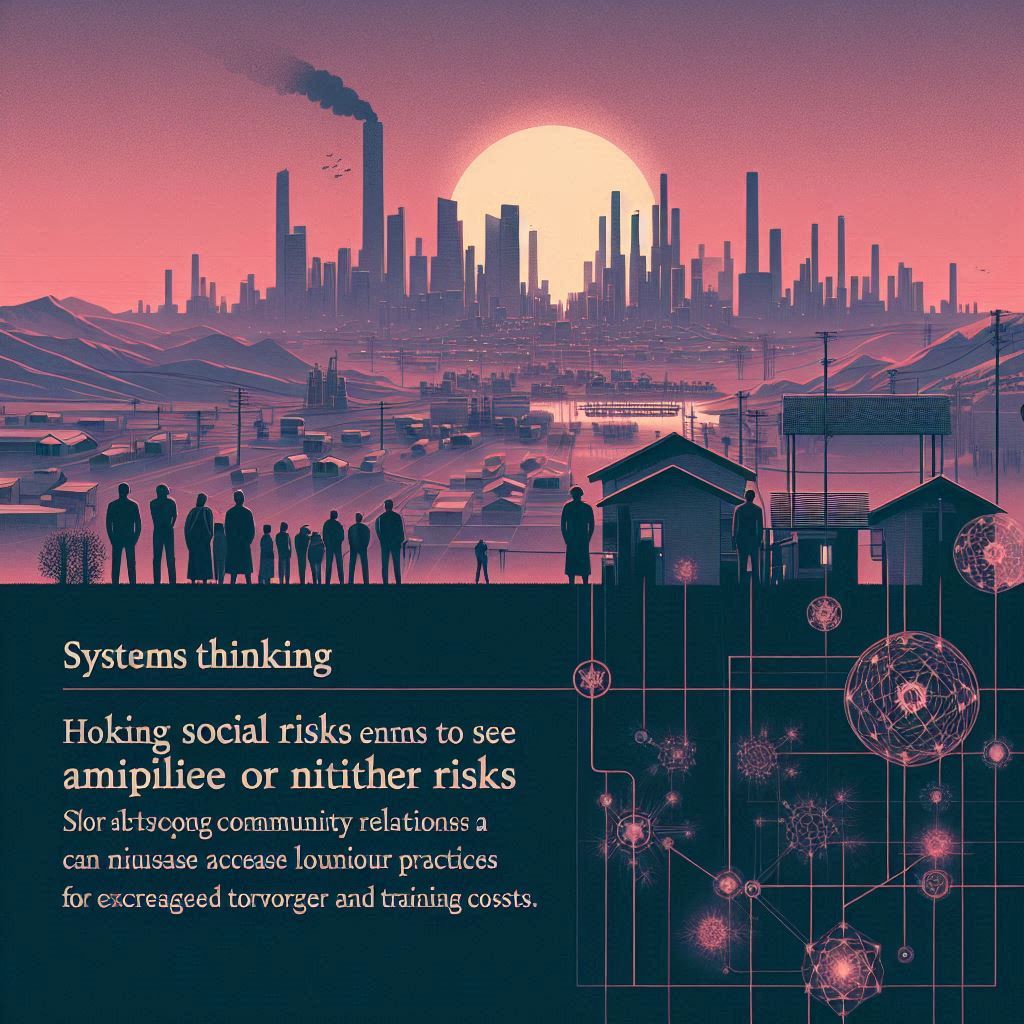
Environmental Lens: Sustainability and Ecological Impact
The environmental lens focuses on the sustainability and ecological impact of managing physical assets. Environmental risks include climate change, resource scarcity, and pollution. First principles thinking leads us to question the long-held practices that contribute to these risks: Are there more sustainable ways to manage our assets? How do our operations affect the natural environment?
With systems thinking, we explore the broader implications of environmental risks. The degradation of one asset can have a domino effect, leading to increased regulatory scrutiny and social backlash. Conversely, proactive environmental stewardship can enhance an organization’s reputation and open up new opportunities. Integrating environmental considerations into risk management is not just an ethical imperative but also a strategic advantage.


Other Lenses: Technological, Regulatory, and Cultural
Additional lenses, such as technological, regulatory, and cultural, also play a role in shaping risk perception. Technological risks relate to the pace of innovation and the threat of obsolescence. Regulatory risks stem from changes in laws and compliance requirements. Cultural risks involve the values and behaviours within an organization and its broader industry. First principles thinking encourages us to identify the foundational factors that give rise to these risks.
Employing systems thinking, we recognize that these lenses do not operate in isolation. Technological advancements can trigger regulatory changes, which in turn can influence cultural norms. A holistic view of risk management considers the interplay between these lenses and their collective impact on physical asset management.


By analysing risk through various lenses and questioning the assumptions behind each, we can gain a deeper understanding of the challenges and opportunities in managing physical assets. First principles thinking provides the clarity to see risks in their most basic form, while systems thinking offers the insight to navigate the complex web of interactions between them. Together, these approaches enable asset managers to perceive and manage risks with greater precision and foresight.



IV. The Horizons of Risk in Asset Lifecycles
In the realm of asset management, the concept of time is not merely a chronological measure but a spectrum of potentialities where risks can emerge, evolve, and dissipate. The horizons of risk – short, medium, and long-term – represent distinct temporal landscapes, each with its own set of challenges and opportunities for managing physical assets. This section will explore these horizons in the context of asset management, emphasizing the critical role of horizon scanning in proactive maintenance and risk mitigation. We will employ first principles thinking to redefine what we understand by time horizons and use systems thinking to anticipate and prepare for the evolution of risks over time.
Short-Term Horizon: Immediate Risks and Reactive Maintenance
The short-term horizon encompasses risks that require immediate attention. These are the risks that, if left unaddressed, can lead to abrupt disruptions in operations. Examples include equipment malfunctions, safety hazards, or sudden regulatory changes. First principles thinking urges us to ask: What are the immediate causes of these risks? How can we address them at their root to prevent recurrence?
In this horizon, proactive asset maintenance is crucial. It involves regular inspections, timely repairs, and swift incident responses. Systems thinking in the short-term horizon is about understanding the immediate cause-and-effect relationships. It’s about ensuring that the quick fixes of today do not become the chronic problems of tomorrow.


Medium-Term Horizon: Emerging Risks and Preventive Strategies
The medium-term horizon is characterized by risks that are on the rise but have not yet fully manifested. These could be technological trends that threaten to make current assets obsolete or demographic shifts that could alter market demands. First principles thinking challenges us to deconstruct these emerging trends to their fundamental drivers: What technological advancements are on the horizon? How might demographic changes impact asset utilization?
Horizon scanning in the medium term involves identifying these emerging risks early on and developing preventive strategies. Systems thinking here means looking beyond the immediate impacts and understanding how today’s emerging risks could become tomorrow’s pressing issues. It’s about building resilience into the system by preparing for these eventualities.


Long-Term Horizon: Strategic Risks and Sustained Adaptation
The long-term horizon is where strategic risks reside. These are the risks that have the potential to redefine the very landscape in which an organization operates. They could stem from climate change, geopolitical shifts, or long-term economic cycles. First principles thinking leads us to consider the foundational changes that could occur: How might climate change alter the geography of our operations? What are the long-term economic trends that could affect asset valuation?
In the long-term horizon, systems thinking is about forecasting and adaptation. It’s about understanding the slow-moving but powerful forces that can reshape the environment in which assets exist. Managing risks at this horizon means not just adapting to change, but also influencing the direction of change to the organization’s advantage.

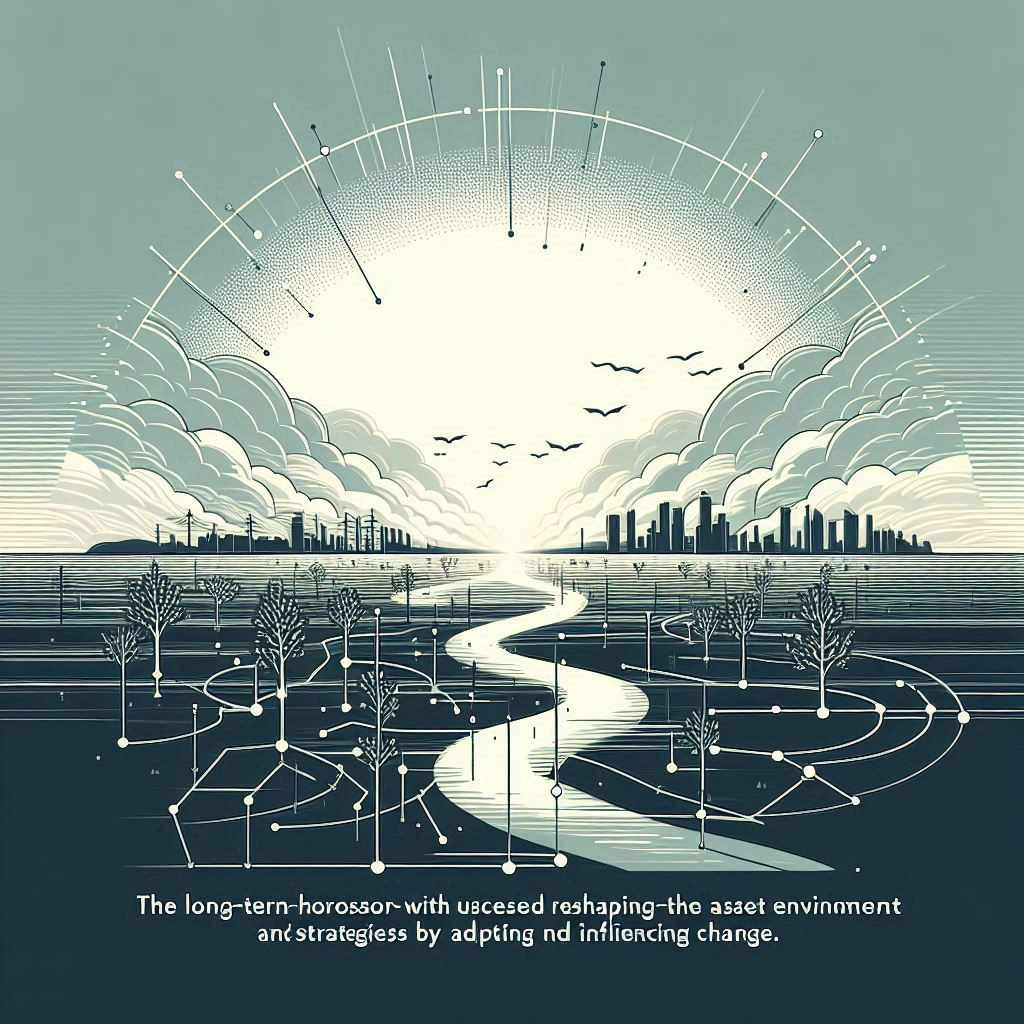
By exploring the horizons of risk in asset lifecycles, we gain a temporal perspective on risk management. First principles thinking allows us to redefine time horizons in a way that is meaningful for asset management, while systems thinking enables us to forecast the evolution of risks and prepare for them. Together, these approaches ensure that asset management is not just about responding to the present but also about shaping the future.



V. Strategic Risks and Physical Asset Management
Strategic risks are those that can fundamentally alter the trajectory of an organization’s future. They are the risks that, if not managed properly, have the potential to compromise the long-term viability of physical assets. This section will examine the impact of strategic risks on physical assets, discuss the importance of strategic alignment in asset management decisions, and apply first principles and systems thinking to assess the broader implications of these risks.
Impact of Strategic Risks on Physical Assets
Strategic risks can take many forms, from shifts in market demand and technological breakthroughs to changes in regulatory landscapes and competitive dynamics. These risks can affect physical assets in several ways. For instance, a shift towards renewable energy sources may render certain fossil fuel-based assets obsolete. Similarly, a breakthrough in construction materials technology could devalue existing infrastructure.
To understand these impacts, we must apply first principles thinking. We start by identifying the fundamental factors that define the value and utility of physical assets. What are the economic, technological, and social conditions that underpin their current and future relevance? By breaking down these factors, we can pinpoint where strategic risks might intersect with our assets’ lifecycles.


Strategic Alignment in Asset Management Decisions
Strategic alignment is the process of ensuring that asset management decisions support the overarching goals and objectives of the organization. It requires a clear understanding of the organization’s strategic vision and the role that physical assets play in achieving that vision. For example, if an organization aims to be a leader in sustainability, its asset management decisions must reflect this by prioritizing investments in energy-efficient technologies and sustainable practices.
First principles thinking helps us to clarify these strategic objectives. It encourages us to ask: What are our ultimate goals? How do our assets serve these goals? From there, we can determine the best course of action for managing our assets in alignment with our strategic vision.


Systems Thinking and Ecosystem-Wide Impacts
Systems thinking allows us to assess the ecosystem-wide impacts of strategic risks. It helps us to see beyond the immediate effects on individual assets and understand how these risks can ripple through the entire asset portfolio and beyond. For example, a strategic risk that affects a key supplier could have implications for the entire supply chain, affecting production schedules, inventory levels, and ultimately, customer satisfaction.
By employing systems thinking, we can map out the network of interdependencies that link our assets to suppliers, customers, regulators, and other stakeholders. This holistic view enables us to anticipate the broader consequences of strategic risks and to develop contingency plans that minimize their impact on our assets and the wider ecosystem.


In conclusion, managing strategic risks in the context of physical asset management requires a deep understanding of the factors that influence the long-term viability of assets. It necessitates strategic alignment to ensure that asset management decisions propel the organization towards its goals. First principles thinking provides the clarity to identify core strategic objectives, while systems thinking offers the breadth to assess ecosystem-wide impacts. Together, these approaches form a robust framework for navigating the complex landscape of strategic risks in physical asset management.



VI. Project Risks in Asset Development and Utilization
Projects that involve the development and utilization of physical assets are fraught with risks that can jeopardize their success. These risks can range from cost overruns and delays to quality issues and scope creep. Effective management of these risks is crucial to ensure that projects meet their objectives and deliver value. This section will address the inherent risks in such projects, suggest strategies for managing these risks with an emphasis on agile and robust planning, and utilize first principles and systems thinking to evaluate their organizational impact.
Identifying Inherent Risks in Asset-Related Projects
The first step in managing project risks is to identify them. In the context of physical assets, these risks often include:

Technical Risks: Challenges related to the complexity and technical requirements of the project.

Resource Risks: Issues arising from the availability and management of resources, including materials, labour, and capital.

Schedule Risks: The potential for project timelines to be extended, leading to increased costs and delayed benefits realization.

Environmental Risks: Unforeseen environmental impacts that could delay or disrupt project activities.

Regulatory Risks: Changes in laws or regulations that could impose additional requirements or constraints on the project.
Employing first principles thinking, we dissect these risks to their core components. For technical risks, we ask what specific technical challenges are present and why they exist. For resource risks, we determine the fundamental factors that influence resource availability and allocation. This approach helps us to understand the nature of each risk and to develop targeted strategies to address them.


Strategies for Managing Project Risks
To manage the identified risks, we emphasize the following strategies:

Agile Planning: Adopting an agile approach allows for flexibility and adaptability in project execution. It involves iterative development, regular feedback loops, and the ability to pivot when necessary.

Robust Planning: While agility is important, it must be balanced with robust planning. This includes detailed risk assessments, contingency planning, and clear communication channels.

Risk Mitigation: Implementing risk mitigation measures, such as securing insurance, conducting thorough testing, and establishing strong contracts with suppliers and contractors.

Stakeholder Engagement: Engaging stakeholders throughout the project lifecycle to ensure alignment and to manage expectations.

Continuous Monitoring: Establishing a system for continuous monitoring of project progress and risk exposure. This allows for timely interventions when risks materialize.
Systems Thinking and Organizational Impact
Using systems thinking, we evaluate the organizational impact of project risks. We consider how risks in one area of the project can affect other areas and the organization as a whole. For example, a delay in one phase of the project could have a cascading effect, impacting subsequent phases and other interdependent projects.
Systems thinking also helps us to identify feedback loops and leverage points. Positive feedback loops can amplify project risks, while negative feedback loops can help to stabilize the project. By understanding these dynamics, we can design interventions that not only address the immediate risks but also reinforce the overall stability and resilience of the project.
In conclusion, managing project risks in asset development and utilization requires a comprehensive approach that combines first principles thinking with systems thinking. By breaking down risks to their fundamental elements and understanding their interconnectedness, we can develop strategies that are both agile and robust, ensuring that projects are delivered successfully and contribute positively to the organization’s strategic objectives.



VII. Operational Risks in Daily Asset Management
Operational risks are the hazards and uncertainties that arise in the day-to-day management of physical assets. These risks can stem from a variety of sources, including human error, equipment failure, and process inefficiencies. They directly affect the performance and reliability of physical assets, which in turn can impact an organization’s operational effectiveness and bottom line. This section will focus on the nature of daily operational risks, the critical role of continuous monitoring and incident management, and the application of first principles and systems thinking to understand and mitigate risk propagation.
Understanding Daily Operational Risks
Daily operational risks are often the most immediate and visible threats to asset performance. They include:

Equipment Downtime: Unexpected breakdowns or malfunctions that halt production or service delivery.

Maintenance Issues: Inadequate or delayed maintenance leading to asset degradation.

Human Factors: Errors or accidents caused by staff, which can lead to safety incidents or operational disruptions.

Process Deviations: Variations from established procedures that compromise asset integrity or performance.
To manage these risks effectively, it is essential to implement a robust system of continuous monitoring. This involves the use of sensors, diagnostics, and data analytics to track asset performance in real-time. Such systems can detect anomalies that may indicate impending failures, allowing for pre-emptive action to prevent downtime.


The Role of Continuous Monitoring and Incident Management
Continuous monitoring serves as the eyes and ears of an organization, providing a stream of data that can be analysed for insights into asset health. When combined with effective incident management – a systematic approach to responding to and resolving issues – organizations can significantly reduce the impact of operational risks.
Incident management includes:

Immediate Response: Quick actions taken to address and contain the incident.

Root Cause Analysis: Investigating the underlying causes of the incident to prevent recurrence.

Corrective Actions: Implementing changes to processes, training, or equipment to mitigate risks.

Learning and Improvement: Capturing lessons learned and integrating them into operational practices.
First Principles Thinking in Operational Risk Analysis
Applying first principles thinking to operational risks involves stripping down each risk to its fundamental components. For example, if equipment downtime is a frequent issue, we ask: What are the basic principles of the equipment’s operation? What conditions lead to its failure? This approach allows us to identify the core issues that need to be addressed to improve asset performance.


Systems Thinking for Risk Propagation
Systems thinking enables us to understand how operational risks propagate through an organization. It recognizes that assets do not operate in isolation; they are part of a larger system where the failure of one component can affect others. For instance, the breakdown of a key machine may not only halt production but also cause delays in supply chains and impact customer satisfaction.
By viewing operational processes as interconnected parts of a whole, we can identify patterns, feedback loops, and leverage points. This holistic perspective helps us to develop strategies that not only address individual risks but also enhance the resilience of the entire operational system.
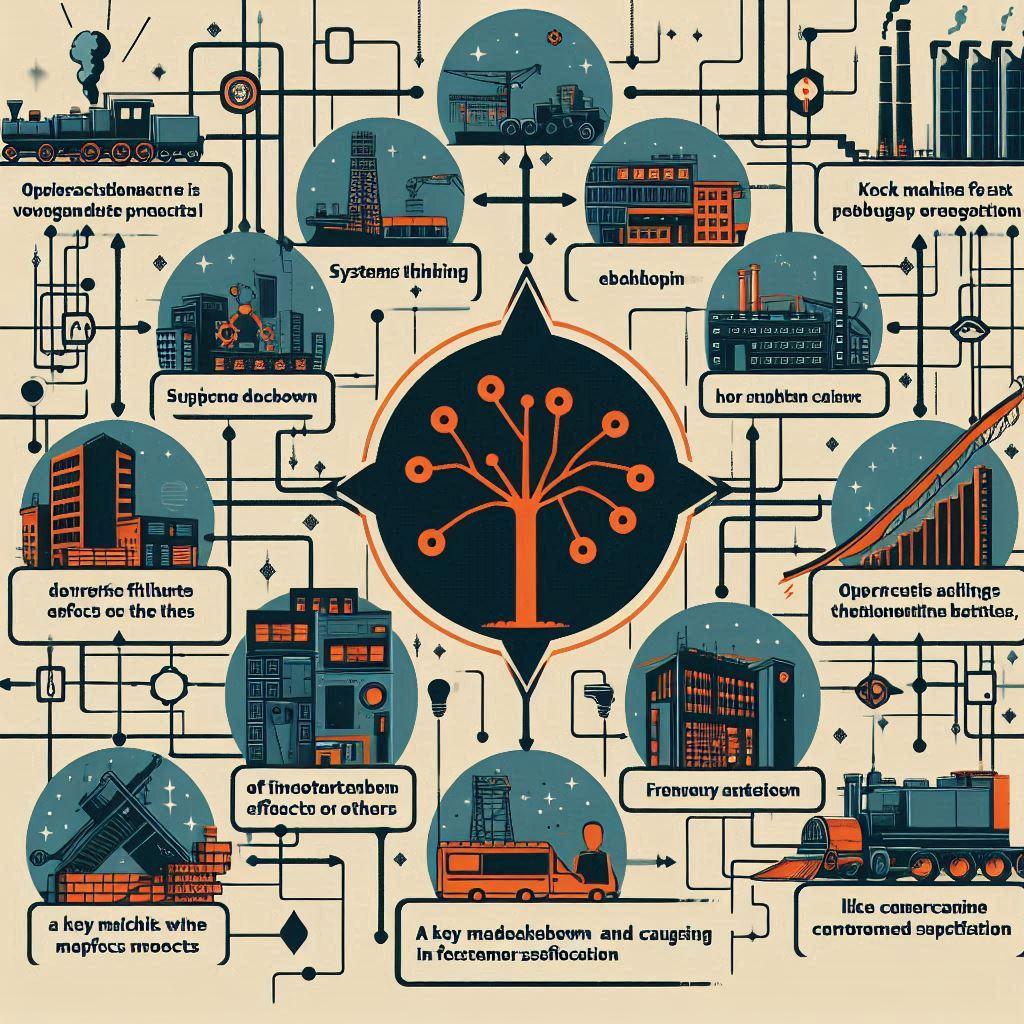

In conclusion, managing operational risks in daily asset management requires a vigilant approach that combines continuous monitoring with swift incident management. First principles thinking provides the clarity to understand the root causes of risks, while systems thinking offers the breadth to see their broader implications. Together, these methodologies enable organizations to maintain high asset performance and reliability, ensuring smooth and efficient operations.



VIII. Identifying and Assessing Asset-Related Risks
The identification and assessment of risks associated with physical assets are pivotal steps in the risk management process. These steps ensure that potential threats to asset integrity and performance are recognized, evaluated, and prioritized for action. This section will detail the methods for identifying asset-related risks, elucidate the role of qualitative and quantitative assessments, and highlight the application of first principles and systems thinking for a comprehensive risk perspective.
Methods for Identifying Asset-Related Risks
Identifying risks specific to physical assets involves a systematic approach that includes:

Asset Inventories: Creating detailed listings of all physical assets, including their locations, conditions, and criticality to operations.

Inspections and Audits: Conducting regular inspections and audits to assess the condition of assets and identify any signs of wear, damage, or potential failure.

Historical Analysis: Reviewing historical data on asset performance, failures, maintenance records, and previous incidents to identify patterns and potential risks.

Stakeholder Consultation: Engaging with stakeholders such as operators, maintenance personnel, and users to gather insights on operational challenges and perceived risks.

Risk Workshops: Organizing workshops with cross-functional teams to brainstorm and identify risks using tools like SWOT analysis, Failure Mode and Effects Analysis (FMEA), and Hazard and Operability Study (HAZOP).
Qualitative and Quantitative Assessments in Asset Risk Management
Once risks have been identified, they must be assessed to determine their potential impact and likelihood. This assessment can be both qualitative and quantitative:

Qualitative Assessments: These involve subjective analysis based on expert judgment, experience, and intuition. Risks are often categorized into levels such as ‘low’, ‘medium’, or ‘high’ based on their perceived severity and probability.

Quantitative Assessments: These use numerical data and statistical methods to measure risk. Techniques include probabilistic modelling, cost-benefit analysis, and Monte Carlo simulations. Quantitative assessments provide a more objective basis for comparing risks and making informed decisions.
Both types of assessments are essential in asset risk management. Qualitative assessments are valuable for gaining insights and understanding the context of risks, while quantitative assessments provide a more rigorous and measurable approach.


First Principles and Systems Thinking for a Holistic Risk View
Employing first principles thinking in risk identification and assessment involves stripping down each risk to its most basic elements. For example, if corrosion is a risk to a pipeline, we ask: What are the chemical and physical processes that lead to corrosion? What environmental and operational conditions exacerbate it?
Systems thinking complements this by providing a holistic view of how risks interact within the larger system. It recognizes that risks are not isolated and that mitigating one risk might inadvertently increase another. For instance, increasing the thickness of a pipeline to reduce corrosion risk might make it more susceptible to installation errors due to its increased weight and rigidity.
By integrating first principles thinking and systems thinking, asset managers can develop fundamental criteria for risk identification and a comprehensive view of risk interdependencies. This dual approach enables a more thorough and nuanced understanding of asset-related risks, leading to more effective risk management strategies.
In summary, identifying and assessing asset-related risks is a multifaceted process that requires a blend of methods and perspectives. By combining systematic identification techniques with qualitative and quantitative assessments, and underpinning these with first principles and systems thinking, organizations can achieve a robust and holistic approach to managing the risks associated with their physical assets. This comprehensive approach not only safeguards assets but also supports the organization’s broader objectives and strategic resilience.




IX. Implementing Holistic Risk Management Strategies
In the dynamic field of asset management, the implementation of holistic risk management strategies is essential for safeguarding physical assets and ensuring their optimal performance. These strategies must be comprehensive, encompassing all aspects of risk identification, assessment, and mitigation. This section will discuss the integration of such strategies with a focus on physical assets, explore innovative approaches informed by first principles, and reflect on systems thinking to validate these strategies. Additionally, we will look at real-world examples to illustrate successful implementations and extract valuable lessons from past asset management failures.
Integrating Comprehensive Risk Management Strategies
The integration of risk management strategies into the lifecycle of physical assets involves several key components:

Lifecycle Analysis: Understanding the entire lifecycle of assets, from acquisition to disposal, to identify potential risks at each stage.

Cross-Functional Collaboration: Bringing together expertise from various departments such as operations, finance, and engineering to ensure a multidimensional approach to risk management.

Technology Utilization: Leveraging technology, including IoT devices and AI analytics, to monitor asset performance and predict potential failures.

Policy and Procedure Development: Establishing clear policies and procedures for risk management that are aligned with organizational objectives and compliant with regulatory standards.

Training and Awareness: Ensuring that all personnel are trained in risk management practices and aware of their role in maintaining asset integrity.
Innovative Strategies Informed by First Principles
Innovative strategies in asset risk management often stem from first principles thinking. This approach involves questioning every assumption about traditional risk management practices and rebuilding strategies from the ground up. For example, instead of accepting scheduled maintenance as the norm, first principles thinking might lead to the adoption of predictive maintenance strategies that are more efficient and cost-effective.


Validating Strategies Through Systems Thinking
Systems thinking is crucial for validating the interconnectedness and efficacy of risk management strategies. It requires an understanding of how different components of an organization and its assets interact and influence one another. For instance, a change in maintenance procedures might affect not only the assets’ performance but also employee workflows and customer satisfaction.
Examples of Successful Implementations

Predictive Maintenance: A manufacturing company implemented a predictive maintenance program using sensors and AI algorithms, resulting in a 30% reduction in unplanned downtime.

Integrated Risk Management Software: A utility company adopted an integrated risk management software that provided a centralized platform for risk data, improving decision-making and response times.

Asset Performance Management (APM): An oil and gas company utilized APM solutions to optimize maintenance schedules and improve the reliability of critical equipment, leading to extended asset life and reduced costs.
Lessons Learned from Asset Management Failures

Neglected Risk Assessments: A facility experienced significant losses due to flooding, which could have been prevented with proper risk assessments and the implementation of mitigation measures.

Inadequate Training: A transportation company faced operational disruptions when employees were not adequately trained on new risk management systems, highlighting the need for comprehensive training programs.

Lack of Communication: A construction project suffered delays and cost overruns due to poor communication between stakeholders about risk management responsibilities and procedures.
In conclusion, implementing holistic risk management strategies requires a thoughtful integration of practices that span the entire asset lifecycle. By employing first principles thinking, we can innovate beyond conventional methods, and with systems thinking, we can ensure that our strategies are robust and interconnected. Real-world examples provide valuable insights into the benefits of successful implementations and the pitfalls of failures. Learning from these experiences, organizations can develop resilient risk management frameworks that protect their physical assets and contribute to their long-term success.



X. Practical Applications of Risk Management Concepts
To truly grasp the effectiveness of the risk management strategies discussed, it is essential to see them in action. This section will provide practical examples that illustrate the application of the concepts of scale, lens, horizon, and the integration of first principles and systems thinking in managing physical assets.
Example 1: Scale – Managing Risks at a Manufacturing Plant
At the micro scale, a manufacturing plant might face the risk of equipment failure. By applying first principles thinking, the management team breaks down the equipment’s operation to its basic elements and discovers that excessive vibration is the root cause of frequent breakdowns.
Systems thinking leads them to realize that this vibration is not just affecting the machines but also causing structural stress to the building, potentially leading to a larger issue. As a result, they implement vibration dampeners and revise the equipment maintenance schedule, addressing the problem at its core and preventing further systemic issues.


Example 2: Lens – A Retail Chain’s Response to Market Changes
A retail chain uses the financial lens to assess the risk of declining sales due to changing consumer preferences. First principles thinking prompts them to analyse fundamental consumer behaviours and market trends, leading to the insight that customers are shifting towards online shopping.
With systems thinking, they recognize the need for an omnichannel approach that integrates both physical stores and online platforms. They revamp their business model to include an e-commerce site, which not only mitigates the risk of lost sales but also opens up new revenue streams.
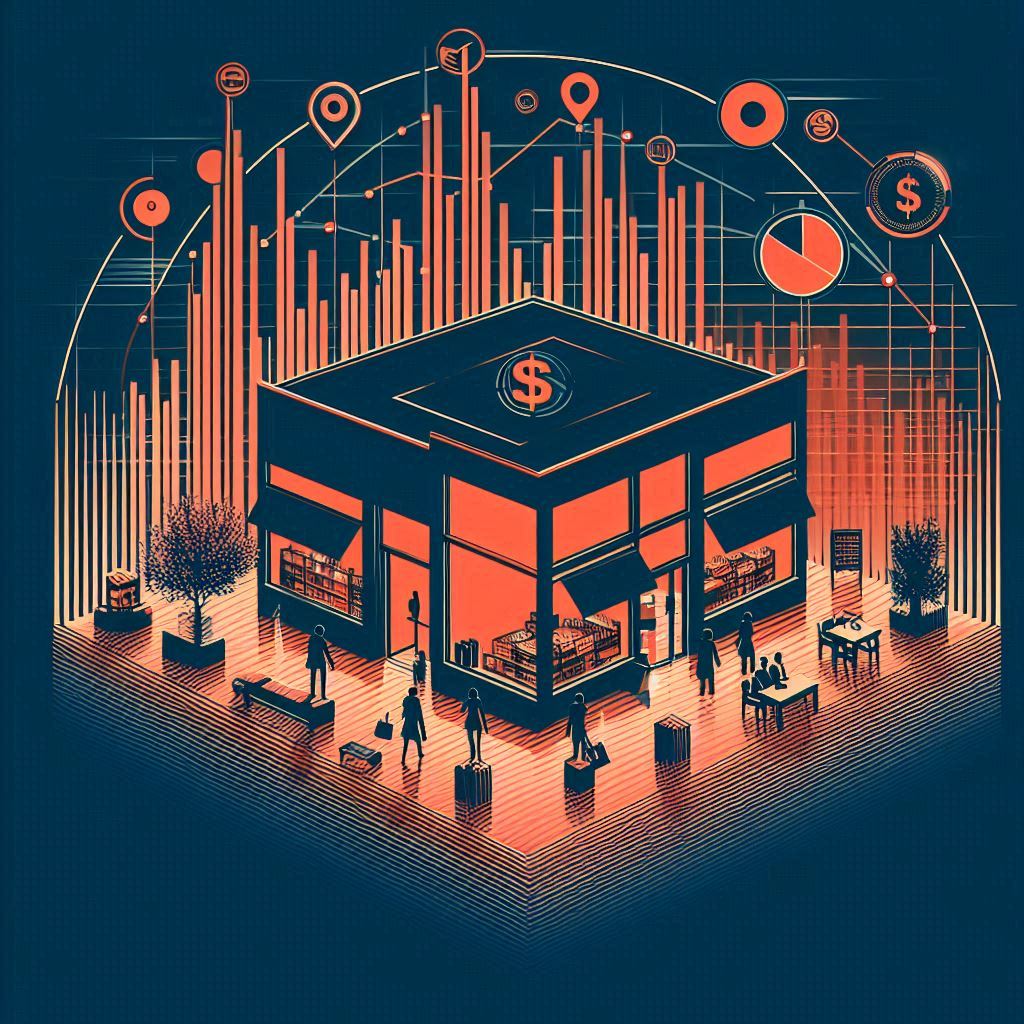

Example 3: Horizon – Long-Term Asset Management in Energy Sector
An energy company looks at the long-term horizon to manage the risks associated with its aging infrastructure. Employing first principles thinking, they question the longevity and efficiency of their current assets.
They then use systems thinking to forecast future energy demands and regulatory changes. This comprehensive analysis leads them to invest in renewable energy technologies, which reduces their long-term strategic risk and positions them as a leader in sustainable energy.


Example 4: Strategic Alignment – Pharmaceutical Company’s Innovation Drive
A pharmaceutical company faces strategic risks from a slow drug development pipeline. By applying first principles thinking, they identify that the bottleneck is due to outdated research methodologies. Systems thinking allows them to see how this issue affects not just R&D but also their market competitiveness.
They implement a new innovation strategy that includes partnerships with biotech start-ups and investments in AI-driven drug discovery, aligning their asset management with their strategic goal of accelerating product development.


Example 5: Project Risks – Construction Project’s Risk Mitigation
During a large construction project, the project management team identifies the risk of schedule delays due to uncertain weather conditions. Using first principles thinking, they analyse historical weather patterns and identify the most volatile months.
With systems thinking, they develop a project schedule that minimizes critical outdoor work during these periods and establish contingency plans. This proactive approach prevents delays and ensures the project stays on track.


Example 6: Operational Risks – Hospital’s Equipment Maintenance Program
A hospital implements a continuous monitoring system for its medical equipment to manage operational risks. First principles thinking leads them to understand the specific failure modes of each equipment type. Systems thinking helps them integrate this data into their broader hospital management system, allowing for predictive maintenance and better patient care continuity.
These examples demonstrate how the principles of risk management can be practically applied across various industries and scenarios. By employing first principles and systems thinking, organizations can develop nuanced and effective strategies that address the complexities of managing physical assets and the risks associated with them. These real-world applications serve as a testament to the value of a comprehensive approach to risk management.


Here are additional examples for each dimension of risk management, illustrating how they can be applied in various contexts:
Scale: Hospital’s Asset Management

Micro Scale: A hospital identifies the risk of a critical MRI machine failing. Using first principles thinking, they determine that the cause is an outdated cooling system. Systems thinking reveals that this could lead to increased patient wait times and reduced care quality. They upgrade the cooling system and adjust patient scheduling to mitigate this risk.

Meso Scale: The same hospital recognizes the risk of power outages affecting multiple departments. They install backup generators and implement cross-departmental training, ensuring that all areas can function independently if needed.
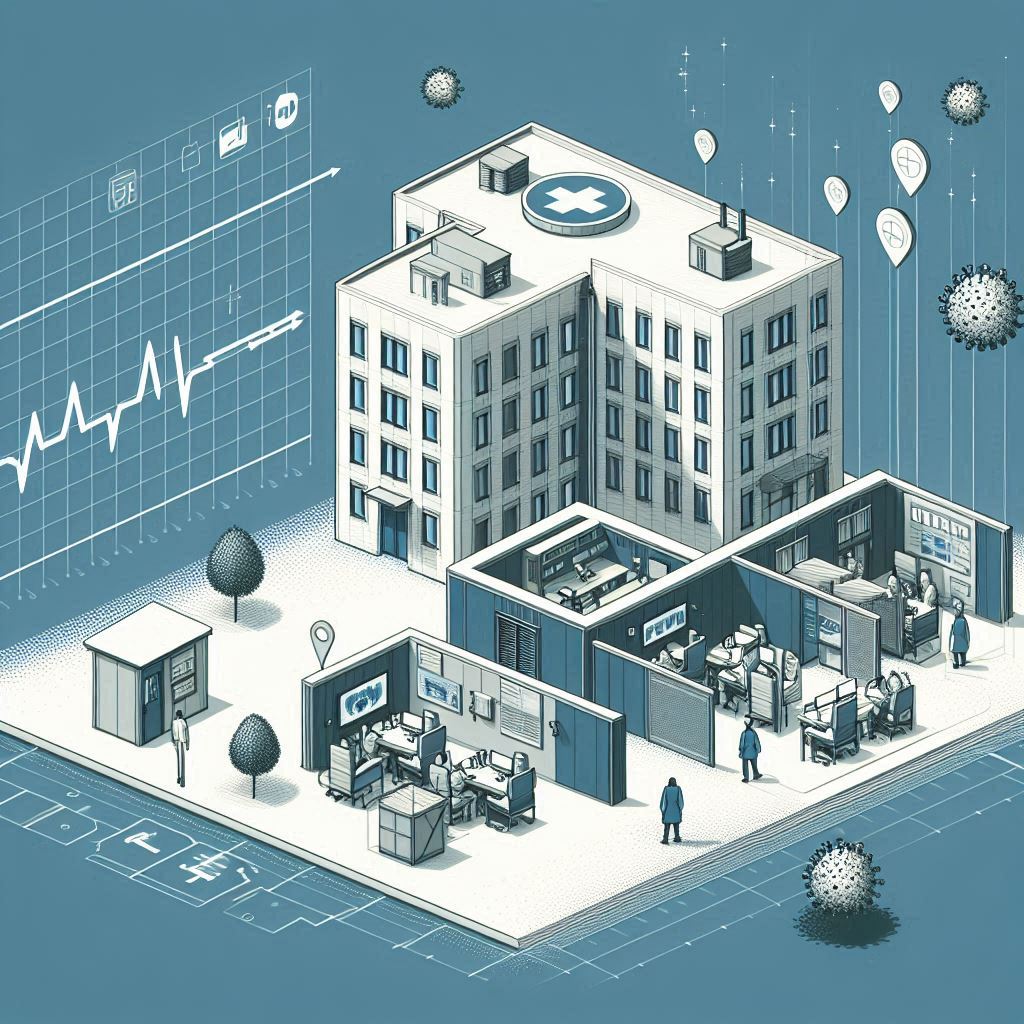
Macro Scale: On a larger scale, the hospital assesses the risk of a pandemic affecting their operations. They develop a comprehensive pandemic response plan, including telehealth services and modular spaces for patient overflow.
Lens: Agricultural Company’s Risk Management

Financial Lens: An agricultural company uses financial modelling to assess the risk of crop failure due to market volatility. They diversify their crops and invest in futures contracts to hedge against price fluctuations.

Social Lens: The company also considers social risks, such as community opposition to certain farming practices. They engage with local stakeholders and adopt more sustainable methods to maintain their social license to operate.

Environmental Lens: Facing environmental risks like drought, the company invests in water-efficient irrigation systems and soil moisture sensors to ensure sustainable water usage.
Horizon: Technology Firm’s Strategic Planning

Short-Term Horizon: A tech firm identifies the risk of software bugs in a new release. They implement a rapid response team and a hotfix protocol to address issues as they arise.

Medium-Term Horizon: Anticipating the emergence of new technologies, the firm invests in R&D to stay ahead of the curve and avoid obsolescence.

Long-Term Horizon: Looking at long-term strategic risks, the firm assesses the potential impact of regulatory changes on data privacy. They proactively develop more secure data handling processes to future-proof their products.
Strategic, Project, and Operational Risks: Construction Company’s Comprehensive Approach

Strategic Risks: The construction company evaluates the risk of market downturns affecting long-term projects. They create a flexible project portfolio that can adapt to changing market conditions.

Project Risks: For project risks, they implement advanced project management software to track progress and identify potential delays or cost overruns early.

Operational Risks: On the operational side, they focus on the risk of workplace accidents. They enhance safety protocols and conduct regular training sessions to maintain a safe working environment.
These examples demonstrate how the dimensions of risk management can be applied across different industries and scenarios. By considering the scale, lens, horizon, and types of risks, organizations can develop tailored strategies that address the specific challenges they face, ensuring the resilience and sustainability of their operations and assets.

XI. Conclusion: Embracing a Multidimensional Approach to Risk Management
Throughout our exploration of risk management within the realm of physical asset management, we have delved into the multifaceted nature of risks that organizations face. We have identified that risks are not monolithic; they vary in scale, scope, and complexity. From the micro risks affecting individual assets to the macro risks that can impact an entire organization’s portfolio, understanding the dimensions of risk is crucial for effective management.
We have seen that a multidimensional approach to risk management is essential. By considering the various lenses through which risks can be viewed – financial, social, environmental, technological, regulatory, and cultural – we gain a comprehensive understanding of potential impacts. This approach allows us to evaluate risks not just in isolation but in the context of their broader implications for the organization.
Here’s a summary of those dimensions:

Scale: This dimension refers to the size and extent of a risk, ranging from micro (individual assets or small groups) to macro (entire organizations or global markets). It’s about understanding the potential reach and impact of a risk.

Lens: Risks can be viewed through different ‘lenses’ such as financial, social, environmental, technological, regulatory, and cultural. Each lens offers a unique perspective on the potential consequences and implications of risks.

Horizon: This dimension involves the time frame over which risks may occur. Short-term risks require immediate attention, medium-term risks involve emerging threats, and long-term risks encompass strategic challenges that can affect the organization’s future.

Strategic Risks: These are risks that can affect an organization’s long-term goals and objectives. They are often related to changes in the external environment, such as market shifts or new regulations.

Project Risks: These risks are specific to project execution and can impact scope, schedule, cost, and quality. They are often associated with the unique challenges of managing complex projects.

Operational Risks: These are the risks faced in the day-to-day operations of an organization. They can include process inefficiencies, equipment failures, and human errors.
Incorporating these dimensions into a risk management process ensures a comprehensive approach. By applying first principles thinking, we break down each risk to its fundamental components, and with systems thinking, we consider the interconnections and interactions between different risks and parts of the organization. This holistic view is essential for effective risk management.
The adoption of first principles thinking has emerged as a powerful tool in our risk management arsenal. It encourages us to dissect complex problems into their most basic elements, stripping away layers of assumptions to reveal the core issues. This method fosters clarity and prevents the oversight of fundamental risks that could undermine asset integrity and performance.
Systems thinking complements first principles thinking by providing a holistic perspective. It enables us to see the interconnectedness of risks and their potential compound effects across the organization. This mindset is invaluable for anticipating how changes in one area can ripple through to others, ensuring that risk management strategies are robust, coherent, and aligned with the organization’s objectives.
From our comprehensive exploration the key takeaways are:

Adopt a multidimensional approach to risk management.

Consider the scale of risks (micro, meso, and macro).

Consider the lens through which risks are viewed (financial, social, environmental, technological, regulatory, cultural).

Consider the time horizon of risks (short-term, medium-term, long-term).

Consider the types of risks (strategic, project, operational).

Integrate first principles thinking to break down risks to their fundamental components and challenge assumptions.

Apply systems thinking to understand the interconnectedness of risks and their potential cascading effects across the organization.

Develop risk management strategies that are comprehensive, proactive, and aligned with the organization’s objectives.

Implement a holistic approach to risk management that encompasses all stages of the asset lifecycle, from acquisition to disposal.

Leverage innovative approaches, cross-functional collaboration, technology, and continuous monitoring to identify, assess, and mitigate risks effectively.

Learn from real-world examples and past failures to refine and improve risk management practices continuously.

Embrace a mindset that recognizes risk management as a crucial aspect of physical asset management, essential for safeguarding assets, ensuring operational continuity, and maintaining a competitive edge.
In conclusion, the journey through the dimensions of risk in physical asset management underscores the importance of a comprehensive, nuanced, and dynamic approach. Organizations are encouraged to embrace both first principles and systems thinking to develop asset management strategies that are not only effective in the short term but also resilient in the face of future challenges. By doing so, they can safeguard their assets, ensure operational continuity, and maintain a competitive edge in an ever-changing risk landscape.






Leave a comment